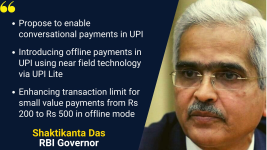Abhishek012
TF Pioneer
UPI Lite now support NFC payment - Three major announcements on UPI made by RBI Today:
* RBI has proposed to enable conversational payments on UPI* Introducing offline payments in #UPI using near field technology (NFC) via UPI Lite
* Enable payment of small amount offline on UPI and raise payment limit via UPI Lite to Rs 500 from Rs 200.

Last edited:




